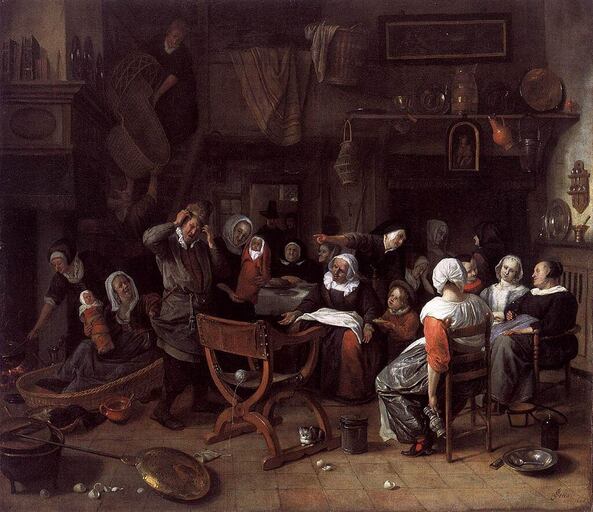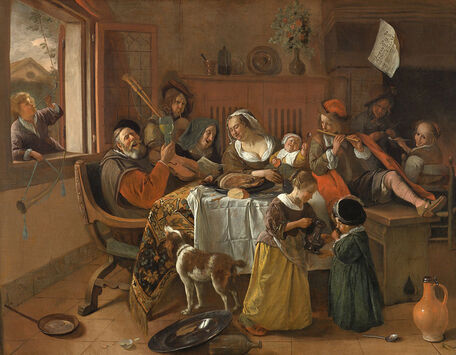|
Where? East Galleries II on the first floor of the Wallace Collection
When? 1664 What do you see? A party to celebrate the arrival of a newborn baby. In the middle, a father holds his newborn. He wears a so-called kraamherenmuts, a typical cap worn by new fathers. On the left, the mother lays in her bed (below the canopy on the top left). Friends and family surround the father and baby. The scene is chaotic but happy. People engage in all sorts of activities, and bowls, pans, plates, egg shells, and food are scattered throughout the room. In the foreground, a maid is shown from the back. She is dressed in happy colors and holds a red chair for the father to sit in. The woman standing on the right side (from our point of view) from the father will receive some money from the father who puts his left hand in a money bag. In the right foreground, a smiling woman is stirring in a large pot and holds up her hand to receive some money as well. Another woman helps her pouring sugar into the pot. The maid on the right is getting a sausage that hangs from the chimney. On the left, two people are paying attention to the mother, and one of them feeds her some soup. To the left of the table, a pregnant woman sits next to a crib. She holds a glass in her left hand and conceals her belly with a white apron. Backstory: This painting has been known under several titles, including The Christening, The Christening Feast, and The Gossiping. Steen signed the painting by writing JSteen.1664 above the door. In addition, the long-haired man behind the father may be a self-portrait of Jan Steen. The painting has been altered a bit over time, but a large cleaning in 1983 removed some of the 19th-century additions. For example, you can still see that the plate in the hand of the woman on the right (getting the sausage) was originally larger. Sir Richard Wallace acquired the painting on May 15, 1872. Jan Steen made several other paintings about the celebration of the birth of a child. For example, in 1668, he painted Twin Birth Celebration, which is in the Kunsthalle in Hamburg.
Symbolism: The marriage between the husband and wife is not good as there are hints that both are cheating on each other (see the fun fact below for more on this). The broken egg shells in the foreground could both symbolize the lack of sexual intercourse within the marriage and sexual intercourse outside the marriage (also notice the bits of egg yolk on the floor). The eggs were also used to produce an alcoholic cinnamon-based drink which was a traditional drink for the mother to recover from the childbirth.
The item on the bottom left, which looks like a frying pan, is a bed warmer. It refers again to the bad state of the marriage as the bed warmer indicates the only warmth there is in bed. Furthermore, the sausage hanging on the top right is also a sexual reference. Steen wanted to remind people with this painting of the importance of a good marriage. Who is Steen? Jan Havickszoon Steen (1626-1679) was a painter from The Netherlands who is best known for the comical and ironic themes in his paintings. His works often include chaotic scenes from everyday life. Typical examples are The Merry Family in the Rijksmuseum in Amsterdam and Rhetoricians at the Window in the Philadelphia Museum of Art. However, he was quite versatile and also created mythological, religious, still-life, and portrait paintings. Jan Steen was the son-in-law of Jan van Goyen, a successful landscape painter from the 17th century. Steen did not always earn enough money with his paintings and ran a brewery and an inn at different points in his life. Observing people having some drinks must have been a great inspiration for Steen as this is a theme that he frequently incorporated in his paintings.
Fun fact: Typical for Jan Steen, this painting contains some comical details, but at the same time these details completely change the meaning of the painting. For example, look right above the head of the baby. A man is raising his two fingers, which was a sign of infidelity. It is a sign that the man raising his fingers is the birth father of the child, while the man holding the baby is only the official father (as his wife has cheated on him). The woman on the right with the large breasts jokingly opens her hand to receive some money from the father. She may be the midwife, but also a little bit more than that…
Interested in a copy for yourself? Poster or canvas.
Written by Eelco Kappe
References:
0 Comments
Leave a Reply. |
Categories
All
|
- Home
- Blog
-
Museums
- Alte Pinakothek
- Art Institute of Chicago
- Baltimore Museum of Art
- Barber Institute of Fine Arts
- Bargello
- Barnes Foundation
- British Museum
- Church of Sant’Anastasia
- Cleveland Museum of Art
- Courtauld Institute of Art
- Detroit Institute of Arts
- Frans Hals Museum
- Galleria Borghese
- Gallerie dell'Accademia
- Getty Museum
- Guggenheim
- Hermitage Museum
- Kunsthistorisches Museum
- Kunstmuseum Basel
- Legion of Honor Museum
- Louvre
- Mauritshuis
- Metropolitan Museum of Art
- Musee d’Orsay
- Museum of Fine Arts in Boston
- Museum of Modern Art
- National Gallery in London
- National Gallery of Art
- National Museum in Poznań
- Norton Simon Museum
- Ny Carlsberg Glyptotek
- Palace of Versailles
- Palazzo Pitti
- Palazzo Vecchio
- Petit Palais
- Philadelphia Museum of Art
- Prado
- Pushkin Museum
- Ravenna Art Museum
- Rijksmuseum
- San Diego Museum of Art
- Santa Maria delle Grazie
- St. Peter's Basilica
- Städel Museum
- Statens Museum for Kunst
- Tate Britain
- Tate Modern
- Timken Museum of Art
- Uffizi
- Vatican Museums
- Wallace Collection
-
Artists
- Altdorfer
- Anguissola
- Berlin Painter
- Bosch
- Botticelli
- Boucher
- Bronzino
- Bruegel the Elder
- Brunelleschi
- Cabanel
- Caillebotte
- Canova
- Caravaggio
- Carpeaux
- Cezanne
- Cimabue
- David
- Degas
- Delacroix
- De Maria
- Donatello
- El Greco
- Fontana
- Fra Angelico
- Fragonard
- Gauguin
- Gentileschi
- Gericault
- Gonzalez-Torres
- Goya
- Hals
- Hogarth
- Hokusai
- Ingres
- Leonardo da Vinci
- Lippi, Filippo
- Longhi, Barbara
- Lorrain
- Makovsky
- Manet
- Massys
- Matisse
- Merian
- Michelangelo
- Mochi
- Modigliani
- Monet
- Panini
- Parmigianino
- Perugino
- Picasso
- Pisanello
- Raphael
- Rembrandt
- Renoir
- Reynolds
- Rivera
- Rodin
- Rubens
- Scultori
- Seurat
- Steen
- Tintoretto
- Titian
- Toulouse-Lautrec
- Turner
- Uccello
- Van der Weyden
- Van Dyck
- Van Eyck
- Van Gogh
- Van Hemessen
- Vasari
- Velazquez
- Vermeer
- Veronese
- Vigée Le Brun
-
Locations
- Books
- About Us




